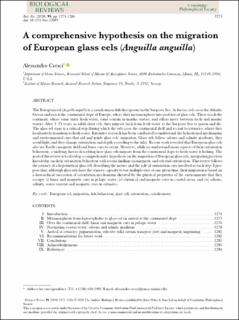| dc.description.abstract | The European eel (Anguilla anguilla) is a catadromous fish that spawns in the Sargasso Sea. As larvae, eels cross the Atlantic Ocean and reach the continental slope of Europe, where they metamorphose into post‐larval glass eels. These reach the continent, where some enter fresh water, some remain in marine waters, and others move between fresh and marine waters. After 5–25 years, as adult silver eels, they migrate back from fresh water to the Sargasso Sea to spawn and die. The glass eel stage is a critical step during which the eels cross the continental shelf and recruit to estuaries, where they facultatively transition to fresh water. Extensive research has been conducted to understand the behavioural mechanisms and environmental cues that aid and guide glass eels' migration. Glass eels follow odours and salinity gradients, they avoid light, and they change orientation and depth according to the tides. Recent work revealed that European glass eels also use Earth's magnetic field and lunar cues to orient. However, while we understand many aspects of their orientation behaviour, a unifying theory describing how glass eels migrate from the continental slope to fresh water is lacking. The goal of this review is to develop a comprehensive hypothesis on the migration of European glass eels, integrating previous knowledge on their orientation behaviour with recent findings on magnetic and celestial orientation. This review follows the journey of a hypothetical glass eel, describing the nature and the role of orientation cues involved at each step. I propose that, although glass eels have the sensory capacity to use multiple cues at any given time, their migration is based on a hierarchical succession of orientation mechanisms dictated by the physical properties of the environments that they occupy: (i) lunar and magnetic cues in pelagic water; (ii) chemical and magnetic cues in coastal areas; and (iii) odours, salinity, water current and magnetic cues in estuaries. | en_US |
